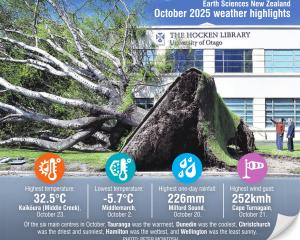
Earth Sciences New Zealand (formerly Niwa) forecasting principal scientist Chris Brandolino said global climate models were strongly signalling the possibility of enhanced low-level convergence in the western Pacific and areas north of New Zealand.
"This could draw tropical and subtropical air masses into our region, increasing the likelihood of wetter-than-normal conditions over the next three months.
"There is therefore an elevated risk for heavy rainfall events, including those associated with landfalling atmospheric rivers."
It could lead to potentially significant rainfall and flooding events, he said.
However, it also meant seasonal air temperatures between July and September were expected to be above average across all regions of New Zealand.
"Thus, while cold snaps and frost will occur, they are expected to be less frequent than usual."
Around coastal Otago, temperatures were most likely to be above average, rainfall totals were about equally likely to be above normal or near normal, and soil moisture levels and river flows were about equally likely to be near normal or above normal, he said.
"Chances for heavy rainfall events are considered elevated during the three-month period, potentially leading to flooding, particularly in areas with saturated soils."
On the West Coast, Southern Alps and foothills, inland Otago, and Southland, temperatures were also most likely to be above average, he said.
But rainfall totals were about equally likely to be near normal or below normal, soil moisture levels were about equally likely to be near normal or above normal, and river flows were most likely to be near normal.
Mr Brandolino said Enso-neutral weather conditions remained present in the tropical Pacific.
Last month, atmospheric patterns in the Pacific continued to be intermittently consistent with weak La Nina conditions, but more recently, ocean temperatures had shifted away from previous La Nina-like characteristics.












